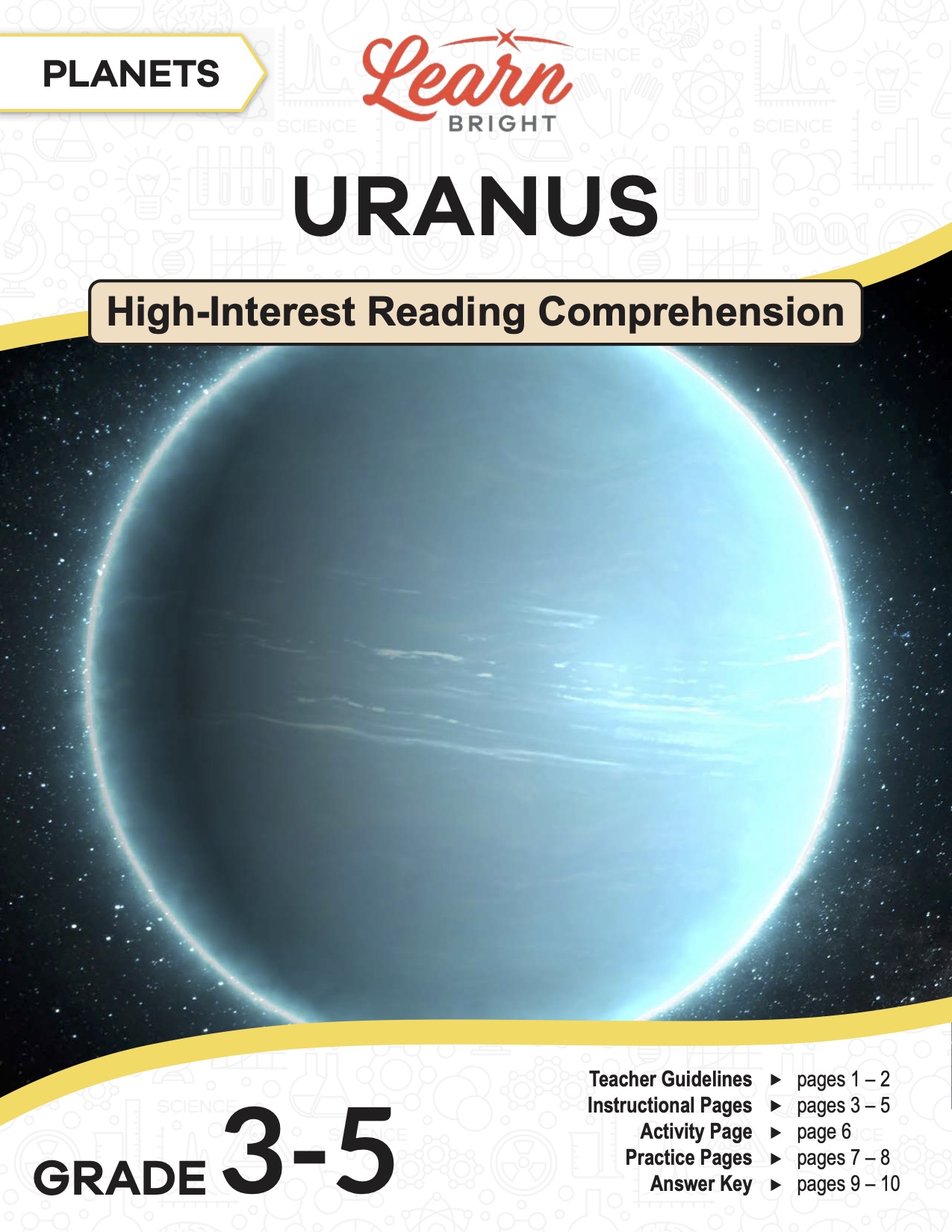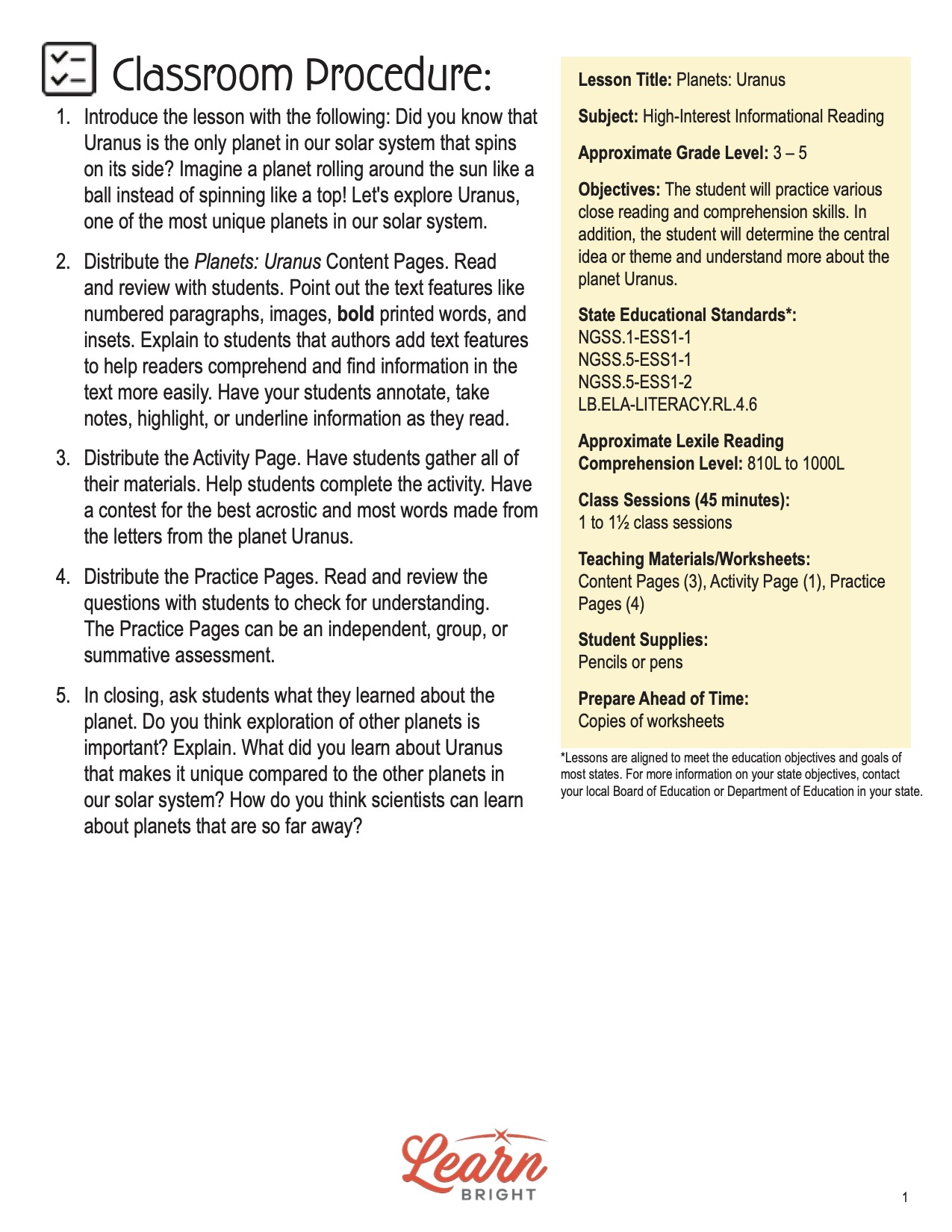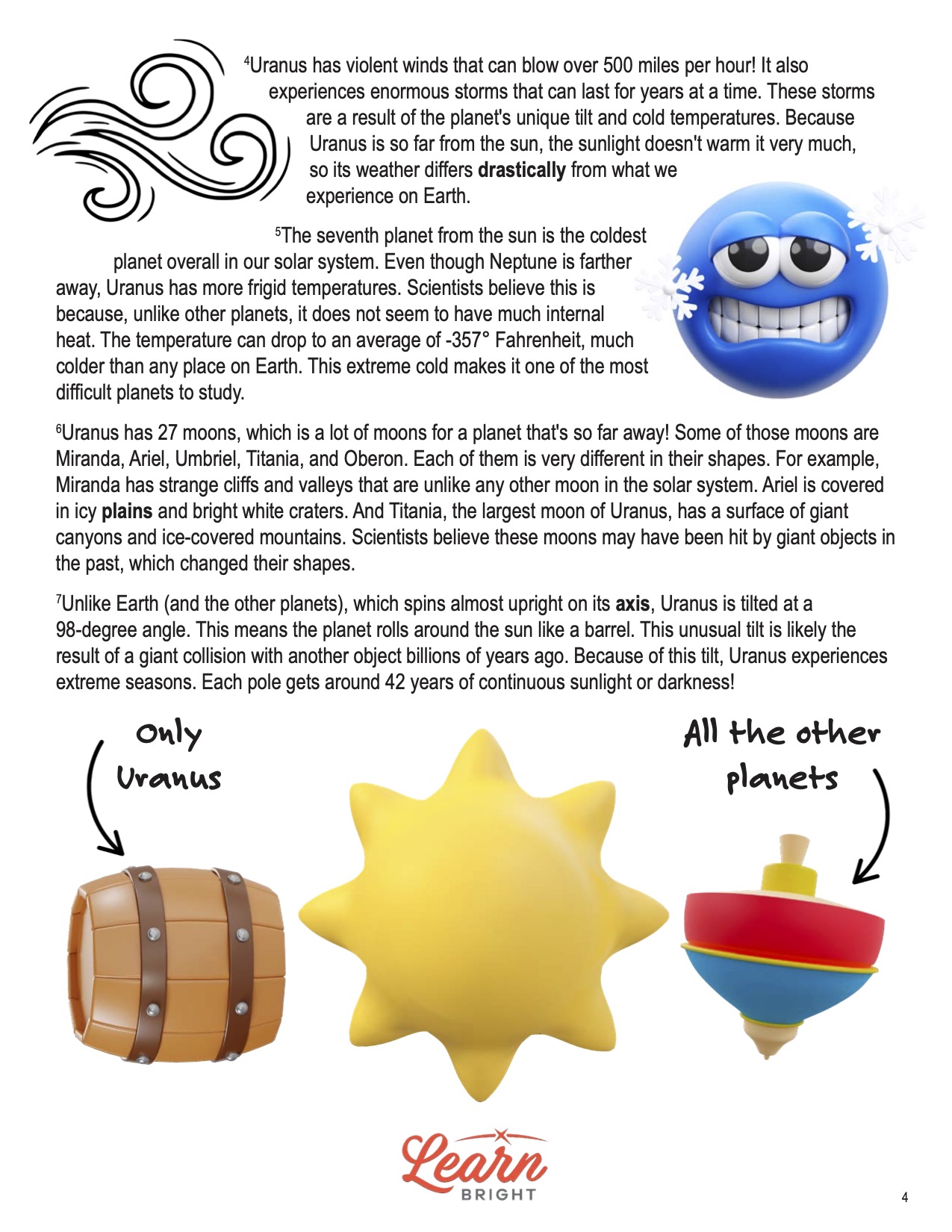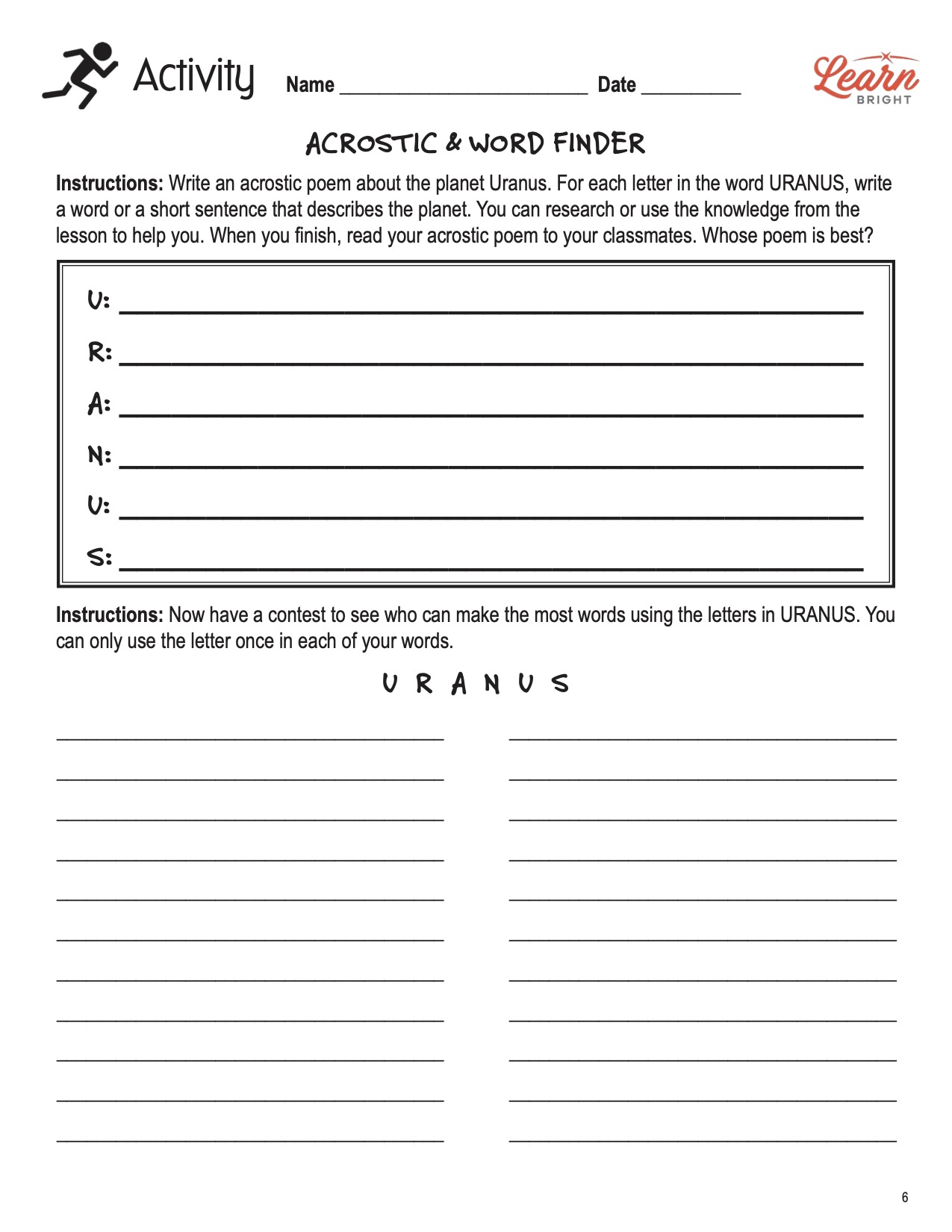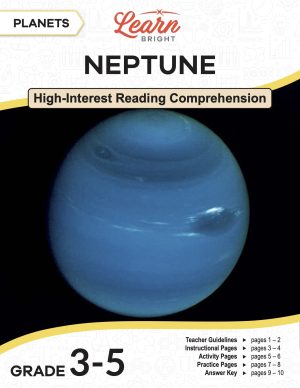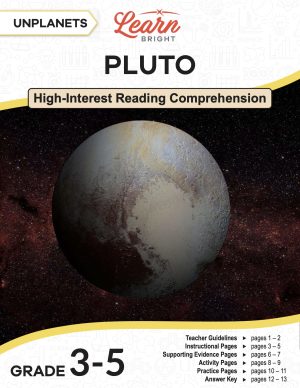Description
What our Planets: Uranus lesson plan includes
Lesson Objectives and Overview: Planets: Uranus is a high-interest reading comprehension lesson plan. As such, students will practice various close reading and comprehension skills. In addition, they will learn about this large and beautiful gas giant in our solar system. This lesson is for students in 3rd grade, 4th grade, and 5th grade.
Classroom Procedure
Every lesson plan provides you with a classroom procedure page that outlines a step-by-step guide to follow. You do not have to follow the guide exactly. The guide helps you organize the lesson and details when to hand out worksheets. It also lists information in the yellow box that you might find useful. You will find the lesson objectives, state standards, and number of class sessions the lesson should take to complete in this area. In addition, it describes the supplies you will need as well as what and how you need to prepare beforehand. The activity requires a number of supplies, including CDs, foam balls, and paperclips. You may want to cut the foam balls in half ahead of time.
Teacher Notes
The teacher notes page provides an extra paragraph of information to help guide the lesson and remind you what to focus on. It explains that you can teach this lesson in a whole-class setting or as an independent, small-group activity. The blank lines on this page are available for you to write out thoughts and ideas you have as you prepare the lesson.
PLANETS: URANUS LESSON PLAN CONTENT PAGES
Introduction to Uranus
The Planets: Uranus lesson plan contains three content pages. Uranus is a particularly unique planet in our solar system. As the seventh planet from the sun, it is far, far away from Earth. In fact, it’s about 1.8 billion miles from our planet! Its name comes from Greek mythology after the ancient Greek god of the sky. Because it is one of the outer planets, it’s very different from the ones we see closest to the sun, like Earth and Mars.
This planet looks like a big blue ball floating in space, but it’s not made of rock or land like Earth. In fact, It has no solid surface at all that you could stand on. Instead, Uranus is made mainly of gas, with some ice and liquid. The planet’s color is a beautiful pale blue-green. That’s why naming it after the god of the sky makes so much sense!
Similar to other planets, Uranus has rings made of dust and ice, but they’re really hard to see. The atmosphere of Uranus consists mostly of hydrogen, helium, and methane, which make it different from the air we breathe on Earth. The blue color comes from the methane gas in its atmosphere, similar to Neptune. Methane absorbs red light from the sun and reflects the blue-green light, giving the planet its unique color. Scientists are also interested in the clouds of Uranus, which move very fast and can change quickly. The atmosphere is also frigid, but the planet’s interior may be hotter. This is one of the mysteries scientists are still trying to solve.
Moons and Temperature
Uranus has violent winds that can blow over 500 miles per hour! It also experiences enormous storms that can last for years at a time. These storms are a result of the planet’s unique tilt and cold temperatures. Because Uranus is so far from the sun, the sunlight doesn’t warm it very much, so its weather differs drastically from what we experience on Earth.
The seventh planet from the sun is the coldest planet overall in our solar system. Even though Neptune is farther away, Uranus has more frigid temperatures. Scientists believe this is because, unlike other planets, it does not seem to have much internal heat. The temperature can drop to an average of -357° Fahrenheit, much colder than any place on Earth. This extreme cold makes it one of the most difficult planets to study.
Uranus has 27 moons, which is a lot of moons for a planet that’s so far away! Some of those moons are Miranda, Ariel, Umbriel, Titania, and Oberon. Each of them is very different in their shapes. For example, Miranda has strange cliffs and valleys that are unlike any other moon in the solar system. Ariel is covered in icy plains and bright white craters. And Titania, the largest moon of Uranus, has a surface of giant canyons and ice-covered mountains. Scientists believe these moons may have been hit by giant objects in the past, which changed their shapes.
Atmosphere and Geological Features
Unlike Earth (and the other planets), which spins almost upright on its axis, Uranus is tilted at a 98-degree angle. This means the planet rolls around the sun like a barrel. This unusual tilt is likely the result of a giant collision with another object billions of years ago. Because of this tilt, Uranus experiences extreme seasons. Each pole gets around 42 years of continuous sunlight or darkness!
Uranus’s magnetic field also fascinates scientists. Most planets have magnetic fields that align with their poles. But for this planet, its magnetic field is tilted and offset from the planet’s center. This creates unusual patterns of energy and radiation all around it. Scientists are still studying Uranus’s magnetic field to learn more about how it works and why it behaves so differently from other planets.
Even though scientists know a lot about Uranus, they still have many questions. In 1986, NASA’s Voyager 2 spacecraft flew past the planet and took pictures. The pictures gave scientists the first close-up images of it and its moons. But there is still much to learn. There are plans to send more spacecraft to study this gas giant in the future.
Uranus is a fascinating planet with many interesting features. It’s far away, it has many moons, and its strange weather and tilted position make it distinctive. Although we may never visit it, scientists continue to study the planet with special tools, long-range telescopes, and spacecraft. Who knows what amazing discoveries we will continue to make about this beautiful blue planet?
PLANETS: URANUS LESSON PLAN WORKSHEETS
The Planets: Uranus lesson plan includes two worksheets: an activity worksheet and a practice worksheet. Each one will help students solidify their grasp of the material they learned throughout the lesson. You can refer to the classroom procedure guidelines to know when to hand out each worksheet.
ACROSTIC & WORD FINDER ACTIVITY WORKSHEET
For the activity, students will first complete an acrostic poem for the letters of Uranus. Then they will try to find as many words using the letters as they can. They can only use the letters once.
PLANETS: URANUS REVIEW PRACTICE WORKSHEET
The practice worksheet lists 10 questions based on the content. These questions all relate to the content pages, so students will need to refer to them often for the answers. In addition, each question provides which reading tool the question corresponds to, such as text feature, vocabulary, or comprehension.
Worksheet Answer Keys
At the end of the lesson plan document is an answer key for the practice worksheet. The correct answers are all in red to make it easier for you to compare them with students’ responses. If you choose to administer the lesson pages to your students via PDF, you will need to save a new file that omits these pages. Otherwise, you can simply print out the applicable pages and keep these as reference for yourself when grading assignments.

